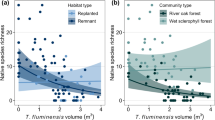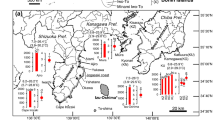Abstract
Plant establishment on sites affected by major volcanic disturbances is limited by several factors, such as lack of suitable microsites for germination and establishment in sites affected by tephra from volcanic eruptions. Even after long periods of time, tephra deposited over un-vegetated areas (agricultural fields and other barren areas) lack closed vegetation cover and in many cases late successional species. To assess limiting factors for plant establishment, a field survey in a tephra deposit from the Paricutin volcano eruption (19°30′42.4′′ N, 102°12′03.0′′) and greenhouse experiments were carried out. The field survey determined the relationship between tephra depth and vegetation distribution. Greenhouse experiments determined the effect of tephra depth on establishment and growth of two dominant species in the tephra deposit surveyed, Eupatorium glabratum and Lupinus elegans. Our results suggest that size and spatial distribution of vegetation patches is related to tephra depth in the field (77% of the vegetation patches were on tephra 38.8 cm deep or less and only 2% on tephra of more than 46.8 cm). Under greenhouse conditions, Eupatorium glabratum and Lupinus elegans height sharply decreased as depth of the tephra layer increased. Lupinus elegans plants growing in tephra less than 30 cm deep had a mean weight of 10.56 g (±0.53 g) compared with 3.11 g (±0.46 g) for plants growing in tephra more than 30 cm deep. Our results suggest that tephra depth is a limiting factor for canopy development in barren areas affected by tephra deposition.
Similar content being viewed by others
References
Antos, J. A. and Zobel D. B. (1986). Seedling establishment in forests affected by tephra from Mount St. Helens. American journal of Botany 73: 495–499
Beaman J.H. (1960). Vascular plants on the cinder cone of Paricutín Volcano in 1958. Rhodora 62: 175–186
Chapin D.M., Bliss L.C. (1989). Seedling growth, physiology, and survivorship in a subalpine, volcanic environment. Ecology 70: 1325–1334
Eggler W.A. (1948). Plant communities in the vicinity of the volcano Paricutín, México, after two and a half years of eruption. Ecology 29: 415 – 437
Eggler W.A. (1959). Manner of invasion of volcanic deposits with further evidence from Paricutín and Jorullo. Ecological Monographs 29: 267–284
Eggler W.A. (1963). Plant life of Paricutín volcano, México, eight years after activity ceased. American Midland Naturalist 69: 38 – 67
Frenzen P.M., Franklin J.F. (1985). Establishment of conifers from seed on tephra deposited by the eruptions of Mount St. Helens, Washington. American Midland Naturalist 114: 84–97
Giménez de Azcárate Cornide J., Escamilla Weinman M.E., Velásquez A. (1997). Fitosociología y sucesión en el volcán Paricutín, Michoacán, México. Caldasia 19: 487 – 505
Jongman R.H.G., Ter Braak C.J.F., Van Tongeren O.F.R. (1995). Data Analysis y Community and Landscape Ecology. Cambridge University Press, Cambridge U.K. pp. 299
Lindig-Cisneros R., Sáenz-Romero C., Alejandre N., Aureoles E., Galindo S., Gómez M., Martínez R. y Medina E. (2002). Efecto de la profundidad de los depósitos de arena volcánica en el establecimiento de vegetación nativa en las inmediaciones del volcán Paricutín, México. Ciencia Nicolaita 31: 47–54
Medina-Sánchez, E., R. Lindig-Cisneros. (2005). Effect of scarification and growing media on seed germination of Lupinus elegans (H.B.K.). Seed Science and Technology 38: 253–255
Rejmánek M., Haagerova R., Haager J. (1982). Progress of plant succession on the Paricutín volcano: 25 years after activity ceased. American Midland Naturalist 108: 194–198
*Statistical Sciences. (1999). S-Plus, Version 2000 for Windows. Mathsoft Inc, Seattle Washington, USA
Titus J.H., Tsuyuzaki S. (2003). Distribution of plants in relation to microsites on recent volcanic substrates on Mount Koma, Hokkaido, Japan. Ecological Research 18: 91–98
Wood D.M., del Moral R. (1987). Mechanisms of early primary succession in subalpine habitats on Mount St. Helens. Ecology 68: 780–790
Wood D.M., del Moral R. (1988). Colonizing plants on the pumice plains, Mount St. Helens, Washington. American Journal of Botany 75: 1228–1237
Zobel D.B., Antos J.A. (1991). Growth and Development of natural seedlings of Abies and Tsuga in old-growth forest. The Journal of Ecology 79: 985–998
Acknowledgements
We thank the Comunidad Indígena de Nuevo San Juan Parangaricutiro for their support to conduct this research. The Gaylord Nelson Institute for Environmental Studies, of the University of Wisconsin-Madison for their support through a gift by Ed Weigner, also to Victoria Cisneros Stoianowski for reviewing the manuscript and two anonymous reviewers.
Author information
Authors and Affiliations
Corresponding author
Additional information
An erratum to this article is available at http://dx.doi.org/10.1007/s11258-006-9176-6.
Rights and permissions
About this article
Cite this article
Gómez-Romero, M., Lindig-Cisneros, R. & Galindo-Vallejo, S. Effect of tephra depth on vegetation development in areas affected by volcanism. Plant Ecol 183, 207–213 (2006). https://doi.org/10.1007/s11258-005-9017-z
Received:
Accepted:
Published:
Issue Date:
DOI: https://doi.org/10.1007/s11258-005-9017-z




